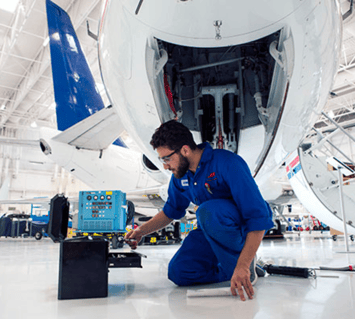By Jay Palter | October 5, 2023
It might not seem so to outsiders, but effective tool management is critical in the aviation industry. Here, safety, efficiency, and strict regulatory compliance are non-negotiable, so it is no wonder that rigorous tool management practices are important under such restrictions. They can be the linchpin that preserves aircraft integrity and safeguards the safety of flight operations.
This article explores how tool management, tailored for aviation maintenance practices, plays an important role in industry operations.
What are the key challenges of aircraft maintenance management?
Understanding the challenges of modern aviation maintenance means first recognizing a rule of thumb of line maintenance operations: the 50% factor. Line maintenance is inherently unpredictable, and roughly half of it is unplanned or rescheduled from their original timetable. This unpredictability extends into other facets of aviation, too. For example, quick decisions related to unforeseen line maintenance tasks often demand real-time staff reassignment, which can, unfortunately, result in reduced workforce efficiency and technical delays.
Communication gaps between cockpit crews, flight operations, and the maintenance control centers further compound the challenge. Communication notably relies on mobile equipment, like phones, computers, and radios—more on that later.
Efficiently scheduling maintenance workers relies on precise data and efficient processes. Maintenance managers often must project workloads months in advance, accounting for different days and specific times. Unavailable technicians, parts inventory, or tools can cause scheduling disruptions.
How can you solve aircraft maintenance problems?
Two of the most effective approaches to modern tool management in the aviation industry are:
- Centralizing your oversight, maintenance, and distribution of tools
- Leveraging the tracking and automated management capabilities of new smart technology systems
Centralize tool management
Efficiently managing tools and maintenance is crucial, especially in an industry like aviation under tight regulations. Beyond regular servicing, commercial aircraft must undergo maintenance after specific flight hours to comply with Federal Aviation Administration (FAA) and International Civil Aviation Organization (ICAO) standards.
Many aircraft fleets grapple with operational inefficiencies despite these regulations stipulating necessary maintenance. These often don’t stem from mechanical failure but communication bottlenecks resulting in unwanted aircraft downtime. Therefore, centralized maintenance tracking and scheduling for aircraft are pivotal.
Maintenance teams can centralize operations manually or with automated software and hardware systems. These systems ensure that routine servicing remains organized and timely, adhering to established schedules. The latest generation of asset and maintenance management systems employ smart technology.
Leverage new smart technology
Incorporating advanced technologies and automation into aviation tool control can significantly enhance maintenance efficiency. Integrated maintenance management systems, automated workflows, and digital documentation minimize administrative burdens, reduce paperwork, and enhance data flow.
Smart technology is the latest generation of business systems equipped with sensors and onboard processors that can monitor their performance, environment, and the tools and people that interact with them. Smart technology, in all its facets, streamlines maintenance operations, mitigates maintenance delays, and optimizes resource allocation—such as critical tool distribution.
How can digital tool management systems improve aviation maintenance?
Cost Reduction
Reactive maintenance practices, where aviation maintenance technicians await component failures before replacement, can lead to more extensive and costly repairs and reduced asset lifespan. Conversely, preventive maintenance often entails stockpiling various parts, incurring expenses, and occupying large amounts of storage. Additionally, scheduling service appointments and check-ups prematurely or unnecessarily consumes valuable time and financial resources.
Predictive maintenance, facilitated by automated tools and part inventory tracking, may involve initial upfront costs but eventually yield savings. By accurately tracking and then forecasting maintenance needs, smart asset management systems eliminate the need for unnecessary repairs and spare parts, ultimately reducing expenses.

Enhanced data gathering
The key new capability of smart technology is data collection. Through their networks of sensors, computers, and access terminals, these systems can gather large volumes of data at practically every touchpoint of maintenance staff’s interactions with tools and inventory.
For example, monitoring tool wear is critical to any agency’s tool maintenance strategy. Traditionally, tools have been replaced based on time-dependent or specific failure criteria, often resulting in underutilization. Data-based tool control in aviation strategies enables the prediction of remaining tool life based on machine signals correlated with wear. This data can be gathered by direct monitoring—sometimes called asset surveillance—or through data collected from technicians at tool sign-out or return.
Airlines can require technicians to log critical information about tools, parts, or workflows when signing out or returning tools using a smart asset management system. That data is then related to integrated central management dashboards that supervisors can monitor.

Streamline maintenance team workflows
Time is of the essence in the aviation industry. A single breakdown in communication can lead to hours of aircraft downtime, potentially resulting in significant financial losses and damage to your company's reputation.
Your aviation maintenance team must collaborate effectively on all tasks to prevent communication breakdowns. Seamless communication and equipment distribution through a unified platform ensures that aircraft fleet managers can access the most current data for aircraft maintenance, work order assignments, and operational cost tracking.
With smart tool management systems, fleet managers and owners can establish custom roles and permission levels, controlling who can sign out which equipment, record data, and access different inventory items. Fleet managers can easily analyze and monitor costs through customizable reports while forecasting asset servicing needs. Additionally, you can export relevant data for generating customized reports and presentations.

Maintain airworthiness and regulatory compliance
One effective approach to guaranteeing aircraft maintenance compliance is directly referencing the FAA regulations and ICAO standards. Integrating compliance checklists into smart asset management systems helps ensure technicians, fleet managers, and other personnel interacting with aircraft and their maintenance processes helps ensure aircraft remain in sound working order and all regulatory burdens are met.
The majority of these regulations emphasize regular inspections and preventive aircraft maintenance. To keep your assets airworthy and in compliance, it's crucial to conduct inspections and preventive maintenance promptly.
Aircraft tool management systems empower your team to perform pre- and post-flight inspections swiftly by facilitating rapid equipment and party transactions. Any discrepancies or issues are promptly logged, and real-time notifications enable your aircraft maintenance team to address and resolve issues promptly.

What are the use cases for smart tool management systems in aviation?
Optimize maintenance scheduling
Efficient planning and scheduling of maintenance operations are essential in reducing aircraft downtime. Using aircraft maintenance management systems, fleet operators can oversee maintenance tasks, monitor the life cycles of components, and schedule all repair and preventative maintenance activities to align with flight hours, planning cycles, and regulatory mandates.
Scheduling optimization guarantees that maintenance operations are conducted at the most cost-effective times. For example, operators can plan maintenance during expected downtime or intervals between scheduled flights to mitigate the risk of costly service interruptions
Tool and inventory control
Utilizing management systems that employ barcode or RFID-based asset tracking can greatly enhance the efficiency of tool inventory management. It is also crucial to adhere to a routine calibration regimen for all precision tools and equipment, following both manufacturer guidelines and federal and international regulations. To facilitate this, establish a well-defined calibration schedule and ensure that tools are calibrated exclusively by accredited calibration facilities. Maintaining meticulous records of calibration dates for reference and compliance is equally important.
Implement Lean Management practices
Introducing Lean Management practices into aircraft maintenance is a potent strategy for streamlining operations. At its core, Lean Management seeks to eliminate waste and enhance operational effectiveness. There are several ways to incorporate Lean Maintenance principles into your existing operations, including:
- Standardized procedures—Developing standardized procedures and work instructions for maintenance tasks to reduce variability and enhance consistency.
- Visual management—Utilizing visual management techniques like color-coded labels and floor signage to diminish search times, making locating tools, parts, and equipment easier.
- 5S Methodology—Embracing 5S (Sort, Set in order, Shine, Standardize, Sustain) to optimize workflows, maintain cleanliness, and promote efficiency in the workplace.
Fostering a culture of continuous improvement is crucial for any organization. Encouraging open communication channels, collaboration, and feedback among maintenance staff can uncover process bottlenecks, inefficiencies, and areas ripe for improvement. Regularly reviewing maintenance procedures, analyzing performance data, and applying lessons learned to empower organizations to refine practices continually and enhance overall efficiency.
Get e-book: 7 Types of Waste that Lean Thinking Organizations Should Avoid
Promote effective collaboration
In aviation maintenance, fostering efficient communication and collaboration among technicians, pilots, engineers, and other stakeholders is essential for achieving optimal efficiency. Maintaining a transparent and timely flow of information regarding maintenance requirements, issues, and updates is essential to mitigate misunderstandings and prevent unnecessary delays.
To enhance collaboration, aviation operators can introduce digital platforms and tools designed to facilitate real-time communication, efficient task allocation, and streamlined progress tracking—for example, smart asset management systems for tool control in the aviation industry. By leveraging these technologies, teams can work together more effectively, ensuring that types of aircraft maintenance operations run smoothly and efficiently.
Manage Aircraft Maintenance Tools Effectively with a Physical Asset Tracking System.
Learn Everything You Need to Know about Asset Tracking Systems.
Subscribe to our blog

Jay Palter
Vice President of Marketing & Partnerships




